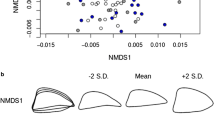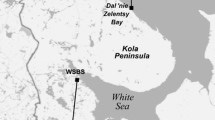Abstract
A study of the sea anemone Actinia equina L. displaying red to brown column coloration was conducted on British shores in 1981 and 1982 in order to assess the ecological significance of discontinuous variation in pedal disc colour. Two ecologically distinct morphs have been revealed. One is characterised by having a red/pink pedal disc, and by being homozygous slow or heterozygous at a hexokinase locus, whilst the other has a grey/green disc and is homozygous fast. The former is relatively more common on the upper-mid shore and on vertical rock faces, whereas individuals of the latter occur more frequently at lower levels, and are relatively more abundant on horizontal surfaces. Correlated with this is a dichotomy in the strength of attachment of the disc to the substratum; anemones having red/pink discs adhere relatively more firmly. Evidence from brood size analysis suggest that the morphs are subject to differential selection; the commoner one at many site examined had a larger median brood size. At present, none of our data on gene-enzyme variation suggests that red to brown anemones in Britain comprise more than one species. Nevertheless, it is argued that local speciation is potentially likely to occur as a result of disruptive selection.
Similar content being viewed by others
Literature cited
Black, R. and M. S. Johnson: Asexual viviparity and population genetics of Actinia tenebrosa. Mar. Biol. 53, 27–31 (1979)
Black, R. and M. S. Johnson: Genetic differentiation independent of intertidal gradients in the pulmonate limpet Siphonaria kurracheensis. Mar. Biol. 64, 79–84 (1981)
Brace, R. C. and J. Pavey: Size-dependent dominance hierarchy in the anemone Actinia equina. Nature, Lond. 273, 752–753 (1978)
Brace, R. C., J. Pavey and D. L. J. Quicke: Intraspecific aggression in the colour morphs of the anemone Actinia equina: the “convention” governing dominance ranking. Anim. Behav. 27, 553–561 (1979)
Brace, R. C. and D. L. J. Quicke: Further analysis of spacing of individuals within aggregations of the anemone Actinia equina L. (In preparation)
Byers, B. A. and J. B. Mitton: Habitat choice in the intertidal snail Tegula funebralis. Mar. Biol. 65, 149–154 (1981)
Cain, A. J.: Breeding system of a sessile animal. Nature, Lond. 247, 289–290 (1974)
Carter, M. A. and C. H. Thorp: The reproduction of Actinia equina L. var. mesembryanthemum. J. mar. biol. Ass. U.K. 59, 989–1001 (1979)
Carter, M. A. and J. P. Thorpe: Reproductive, genetic and ecological evidence that Actinia equina var. mesembryanthemum and var. fragacea are not conspecific. J. mar. biol. Ass. U.K. 61, 79–93 (1981)
Carter, M. A. and J. P. Thorpe: Actinia reproduction and the species problem. Porcupine Newsl., Edinburg 2, 44–45 (1982)
Chia, F.-D. and M. A. Rostron: Some aspects of the reproductive biology of Actinia equina (Cnidaria: Anthozoa). J. mar. biol. Ass. U.K. 50, 253–264 (1970)
Dickinson, H. and J. Antonovics: Theoretical considerations of sympatric divergence. Am. Nat. 107, 256–274 (1973)
Elmhirst, R. and J. S. Sharpe: On the colours of the two sea anemones Actinia equina and Anemonia sulcata. Biochem. J. 14, 48–57 (1920)
Flowerdew, M. W. and D. J. Crisp: Allelic esterase isoxzymes, their variation with season, position on the shore and stage of development in the cirripede Balanus balanoides. Mar. Biol. 35, 319–325 (1976)
Gashout, S. E. and R. F. G. Ormond: Evidence for parthenogenetic reproduction in the sea anemone Actinia equina. J. mar. biol. Ass. U.K. 59, 975–987 (1979)
Giesel, J. T.: On the maintenance of a shell pattern and behavioral polymorphism in Acmaea digitalis, a limpet. Evolution, Lawrence, Kansas 24, 98–119 (1970)
Gosse, P. H.: A history of the British sea anemones and corals, 362 pp. London: Van Voorst 1860
Johnson, M. S. and R. Black: Chaotic genetic patchiness in an intertidal limpet, Siphonaria sp. Mar. Biol. 70, 157–164 (1982)
Koehn, R. K., F. J. Turano and J. B. Mitton: Population genetics of marine pelecypods. II. Genetic differences in microhabitats of Modiolus demissus. Evolution, Lawrence, Kansas 27, 100–105 (1973)
Larkman, A. U. and M. A. Carter: The spermatozoon of Actinia equina. J. mar. biol. Ass. U.K. 60, 193–204 (1980)
Mather, K.: Polymorphism as an outcome of disruptive selection. Evolution, Lancaster, Pa. 9, 52–61 (1955)
Mayr, E.: Population, species and evolution: an abridgement of animal species and evolution, 453 pp. Cambridge, Massachusetts: Harvard University Press 1970
Orr, J., J. P. Thorpe and M. A. Carter: Biochemical genetic confirmation of the asexual reproduction of brooded offspring in the sea anemone Actinia equina. Mar. Ecol. Prog. Ser. 7, 227–229 (1982)
Ottaway, J. R.: Population ecology of the intertidal anemone Actinia tenebrosa. I. Pedal locomotion and intraspecific aggression. Aust. J. mar. Freshwat. Res. 29, 787–802 (1978)
Ottaway, J. R.: Population ecology of the intertidal enemone Actinia tenebrosa. II. Geographical distribution, synonymy, reproductive cycle and fecundity. Aust. J. Zool. 27, 273–290 (1970)
Ottaway, J. R. and G. C. Kirby: Genetic relationship between brooding and brooded Actinia tenebrosa. Nature, Lond. 255, 221–223 (1975)
Ottaway, J. R. and I. M. Thomas: Movement and zonation of the intertidal anemone Actinia tenebrosa Farqu. (Cnidaria: Anthozoa) under experimental conditions. Aust. J. mar. Freshwat. Res. 22, 63–78 (1971)
Polteva, D. G.: Regeneration and somatic embryogenesis of Actinia equina in different stages of ontogenetic development. Acta biol. hung. 14, 199–208 (1963)
Quicke, D. L. J. and R. C. Brace: Phenotypic and genotypic spacing within an aggregation of the anemone Actinia equina L. J. mar. biol. Ass. U.K. 63, 493–515 (1983)
Quicke, D. L. J., A. M. Donoghue, T. F. Keeling and R. C. Brace: Littoral distributions and evidence for differential post-settlement selection of the morphs of Actinia equina L. (In preparation)
Rostron, M. A. and J. Rostron: Fecundity and reproductive ecology of a natural population of Actinia equina L. (Cnidaria: Anthozoa). J. exp. mar. Biol. Ecol. 33, 251–259 (1978)
Schmidt, H.: Taxonomie, Verbreitung und Variabilität von Actinia equina Linné 1766 (Actiniaria: Anthozoa). Z. zool. Syst. EvolForsch. 9, 161–169 (1971)
Shaw, P. R. and R. Prasad: Starch gel electrophoresis of enzymes —a compilation of recipes. Biochem. Genet. 4, 297–320 (1970)
Slatkin, M.: Pleiotropy and parapatric speciation. Evolution, Lawrence, Kansas 36, 263–270 (1982)
Snedecor, G. W. and W. G. Cochran: Statistical methods, 593 pp. Ames: Iowa State University Press 1967
Stephenson, T. A.: The British sea anemones, Vol. 2. 426 pp. London: Ray Society 1935
Tracey, M. L., N. F. Bellet and C. D. Gravem: Excess allozyme homozygosity and breeding population structure in the mussel Mytilus californianus. Mar. Biol. 32, 303–311 (1975)
Author information
Authors and Affiliations
Additional information
Communicated by J. Mauchline, Oban
Rights and permissions
About this article
Cite this article
Quicke, D.L.J., Donoghue, A.M. & Brace, R.C. Biochemical-genetic and ecological evidence that red/brown individuals of the anemone Actinia equina comprise two morphs in Britain. Mar. Biol. 77, 29–37 (1983). https://doi.org/10.1007/BF00393207
Accepted:
Issue Date:
DOI: https://doi.org/10.1007/BF00393207




